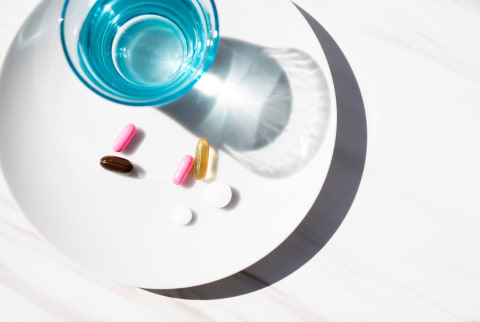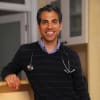Advertisement
Exactly How To Take Probiotics When You're On A Course Of Antibiotics


"I don't want to take antibiotics if I don't have to," said Maya, a patient who had come in to see me for symptoms of a urinary tract infection (UTI). As a doctor who specializes in functional medicine and gut health, I completely sympathized with this patient's plea.
Overprescribed antibiotics are the No. 1 reason for dysbiosis1—an imbalance between good and bad bugs in the gut. They are the reason so many patients come to see me as a gut expert to deal with the consequences of having been placed on multiple rounds of antibiotics for all kinds of infections, from throat infections and sinusitis to bronchitis and UTIs.
Maya was taking all the right natural remedies, and we were trying to nip the infection in the bud before it got so bad it would require antibiotics.
However, I've seen the consequences of delayed antibiotic treatment for an infection seemingly as innocuous as a UTI. If left untreated, bacteria can travel up from the bladder to the kidneys, causing a full-blown kidney infection, resulting in a high fever, back pain, and potentially even a severe form of infection called sepsis (when bacteria gets into the bloodstream)—which will land even the healthiest person in the hospital. Delaying treatment when it is needed in these cases would mean hospitalization with heavy-duty intravenous antibiotics, which no one wants.
So, how do I reconcile being a gut doctor—a champion for protecting the diversity of the gut microbiome—and saving people from any infection that could easily turn serious? It's all about taking strategic steps to minimize and counter the damage with the right supplements, including probiotics. Here, let me share a recent experience of my own and how I handled the situation.
Despite our best efforts, some infections just don't respond to natural treatments.
Recently, I had an unexpected scare of my own. I've been lucky enough to have great teeth all my life, but my gums—that's another story. I knew they were a problem, and I was about to make an appointment to see a holistic dentist when I ended up with a gum infection around a rear molar.
The infection started slowly at first, and I was using all sorts of natural remedies to treat it, from an ozonated gel to gargling with a natural antimicrobial solution. To make matters worse, I was away from my home in New York City at a conference, and I feared the infection would become so severe that I'd have to go on one of the only types of antibiotics that would work for this type of oral infection—which are potent!
Instinctually, I knew I'd probably need an antibiotic, but I did everything in my power to avoid it. Having grown up with irritable bowel syndrome and developing wheat, gluten, and dairy sensitivities as a result of leaky gut syndrome from multiple courses of antibiotics as a teenager, the last thing I want to do is go on antibiotics. In fact, I hadn't touched antibiotics in over a decade. So, this was a really big deal. And the type of antibiotic I would have to take would undeniably mess up my gut flora.
As soon as I got back home, I went to see a holistic dentist who tried injecting ozone and ozonated water into the infected area, but it only calmed things down for 24 hours. And yet, I still didn't want to cave to antibiotics because I knew how much work I'd put into recovering my gut from previous years of damage.
Another dentist I saw offered me Clindamycin, an antibiotic that, for the life of me, I don't understand why dentists use so nonchalantly, as it comes with the highest risk of inducing a secondary infection of the large intestine known as C. Diff. The infection is caused by a bacterium named Clostridium difficile, and it leads to a very severe infection that can be hard to treat. In fact, an unresponsive case of C. diff. is the only FDA-approved reason you can get a fecal transplant. Needless to say, I would never take that risk.
But I was starting to lose the battle with my infection, and after a cone scan to get a better view, another dentist said I might need to pull the tooth if I didn't act fast. That, of course, was enough motivation for me to start antibiotics right away. I chose Amoxicillin/Clavulanate for its efficacy in these types of infections, but I knew I would have to move fast to protect myself from the scourge of this antibiotic on my gut microbiome.
Enter: probiotics.
How to take probiotics to protect your gut from antibiotics.
So, how did I personally protect my gut when I underwent antibiotic treatment, and how do I advise my patients? It's a two-step process:
Take this yeast-based probiotic strain with your antibiotic.
My first go-to is a probiotic, of course—but not a traditional bacteria-based probiotic. It's technically a gut-friendly yeast known as Saccharomyces boulardii.
S. boulardii has been shown in multiple studies2 to protect the lining of the intestines from the type of damage that occurs as a result of a dysbiosis, which can lead to leaky gut syndrome and all the consequences of that, which I've written about in a prior post. It can also protect against the development of a C. difficile infection as a result of antibiotic therapy.
Here's how to take it: Saccharomyces boulardii (with or without a prebiotic like FOS—fructo-oligosaccharides): 2 capsules with each dose of antibiotic (they can be taken together). You want to make sure each capsule has a potency of 5 billion CFUs (colony-forming units—a measure of the strength of the probiotic).
Take a bacteria-based probiotic several hours after your antibiotic.
In terms of the type of probiotic, I talk all about that in this article. But to quickly recap: It's best to look for a multi-strain probiotic with at least 100 billion CFUs. If you travel often, then it's best to look for a brand that is packaged in individual blister seals that doesn't require refrigeration. When taking a probiotic on an antibiotic regimen, however, timing is very important to maximize effectiveness.
Here's how to take it: For many antibiotics, dosing is twice a day every 12 hours. Therefore, you would take your multi-strain, 100 billion CFU probiotic once a day, either before lunch on an empty stomach (at least four hours after the morning antibiotic dose) or before bedtime (at least three to four hours after the evening antibiotic dose). If you're on a three-times-daily antibiotic, then dosing the probiotic would have to move to bedtime.
You'll take this S. boulardii + 100 billion CFU probiotic regimen throughout the course of your antibiotic treatment. Then, once you're done with your antibiotic course, you'll continue the same regimen for one to two months to help your gut continue to recover.
Plus, my go-to supplement to counter antibiotics' energy-draining effects.
Antibiotics don't only affect bacteria. Ever wonder why antibiotics can make you feel so tired? The belief is that they also target the hundreds of little energy factories—or mitochondria—inside each of the cells in your body.
Mitochondria are believed to be ancient bacteria that developed a symbiotic relationship with cells in multicellular organisms such as humans over the course of centuries. Because of their primitive origin, they're also sensitive to many of the same insults that bacteria succumb to, including antibiotics.
Fortunately, there is a supernutrient that has been found to protect these intracellular energy factories from the damaging effects of antibiotics, and you can easily add it to your antibiotic recovery regimen—N-acetyl cysteine (NAC).
NAC increases intracellular stores of the most important detoxifier in the body, glutathione. Glutathione is the mother of all detox molecules and a very important measure of cellular health. It serves as a carrier to help remove toxins from the body. When it comes to mitochondria, it helps protect these sensitive engines from damage.
Here's how to take NAC: One or two 500-mg capsules twice a day (for a total of 1,000 to 2,000 mg daily). I like using higher doses on patients with bronchitis or lung infections, as it also helps move mucus out.
Bottom line: Antibiotics should never be taken lightly, but sometimes they're absolutely necessary—and there's plenty you can do to protect yourself. If you want more guidance on how to balance your gut microbiome and boost overall health, check out my other mbg articles as well as my website for helpful resources.

Vincent M. Pedre, M.D., medical director of Pedre Integrative Health and president of Dr. Pedre Wellness, is a board-certified internist in private practice in New York City since 2004. He completed his bachelor’s degree in Biology at Cornell University before attending the University of Miami School of Medicine and completed his residency in Internal Medicine at the Mount Sinai School of Medicine. He has appeared on the Martha Stewart Show and ABC and is the author of Happy Gut: The Cleansing Program to Help You Lose Weight, Gain Energy, and Eliminate Pain. Dr. Pedre is a clinical instructor in medicine at the Mount Sinai School of Medicine and is certified in yoga and medical acupuncture.
More from the author:
Functional Nutrition Training
Check out Functional Nutrition Coaching
A cutting-edge nutrition deep dive taught by 20+ top health & wellness experts
Learn moreMore from the author:
Functional Nutrition Training
Check out Functional Nutrition Coaching
A cutting-edge nutrition deep dive taught by 20+ top health & wellness experts
Learn more
Vincent M. Pedre, M.D., medical director of Pedre Integrative Health and president of Dr. Pedre Wellness, is a board-certified internist in private practice in New York City since 2004. He completed his bachelor’s degree in Biology at Cornell University before attending the University of Miami School of Medicine and completed his residency in Internal Medicine at the Mount Sinai School of Medicine. He has appeared on the Martha Stewart Show and ABC and is the author of Happy Gut: The Cleansing Program to Help You Lose Weight, Gain Energy, and Eliminate Pain. Dr. Pedre is a clinical instructor in medicine at the Mount Sinai School of Medicine and is certified in yoga and medical acupuncture.